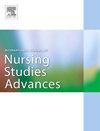Psychometric evaluation of the Norwegian version of the Threadgold Communication Tool
IF 3.1
Q1 NURSING
International Journal of Nursing Studies Advances
Pub Date : 2025-08-06
DOI:10.1016/j.ijnsa.2025.100405
引用次数: 0
Abstract
Objectives
The study aimed to investigate the psychometric properties of the Norwegian version of the Threadgold Communication Tool, a proxy-rated instrument assessing communication abilities in people with dementia.
Design
The study employed a prospective design, with two measurement points within 10 days. The Threadgold Communication Tool was translated into Norwegian following the World Health Organization's protocol for translation and back-translation.
Setting and participants
The study included 126 residents from ten different nursing homes and one assisted living facility in Norway. The participants consisted of 99 women (78.57 %) and 27 men (21.43 %), aged between 61 and 100 years, with a mean age of 85.67 (SD 7.59).
Outcome measures
The outcome measures were the internal consistency, test-retest reliability, and construct validity of the Threadgold Communication Tool.
Results
The Norwegian version of the Threadgold Communication Tool demonstrated satisfactory psychometric properties, with a high level of internal consistency (Cronbach’s α coefficient = 0.95) and robust test-retest reliability (r = 0.8, p < 0.001). Principal Component Analysis revealed a two-component structure, explaining 62.9 % of the variance. However, the item 'vocalization' scored lower than other items and was identified as difficult to interpret by the Sonas Licensed Practitioners.
Conclusions
The Norwegian version of the Threadgold Communication Tool is a reliable and valid tool for assessing communication abilities in people with dementia. However, further research is needed to refine the instrument based on these findings, particularly regarding the interpretation of the 'vocalization' item.
挪威版Threadgold沟通工具的心理测量评估
该研究旨在调查挪威版Threadgold沟通工具的心理测量特性,这是一种评估痴呆症患者沟通能力的代理评级工具。本研究采用前瞻性设计,在10天内设置两个测量点。按照世界卫生组织的翻译和反翻译议定书,将Threadgold通讯工具翻译成挪威语。环境和参与者这项研究包括来自挪威10家不同的养老院和一家辅助生活机构的126名居民。参与者包括99名女性(78.57%)和27名男性(21.43%),年龄在61至100岁之间,平均年龄85.67岁(SD 7.59)。结果测量指标为Threadgold Communication Tool的内部一致性、重测信度和结构效度。结果挪威版Threadgold Communication Tool具有良好的心理测量特性,具有较高的内部一致性(Cronbach’s α系数= 0.95)和稳健的重测信度(r = 0.8, p < 0.001)。主成分分析揭示了双成分结构,解释了62.9%的方差。然而,“发声”这个项目的得分低于其他项目,并且被Sonas执业医师认定为难以解释。结论挪威语版Threadgold沟通工具是评估痴呆患者沟通能力的可靠有效工具。然而,需要进一步的研究来完善基于这些发现的仪器,特别是关于“发声”项目的解释。
本文章由计算机程序翻译,如有差异,请以英文原文为准。
求助全文
约1分钟内获得全文
求助全文
来源期刊

International Journal of Nursing Studies Advances
Nursing-General Nursing
CiteScore
5.80
自引率
0.00%
发文量
45
审稿时长
81 days
 求助内容:
求助内容: 应助结果提醒方式:
应助结果提醒方式:


